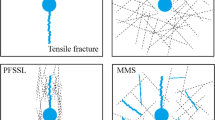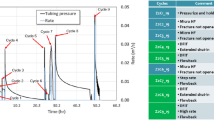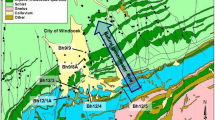Abstract
The Raft River geothermal field, located in southern Idaho, roughly 100 miles northwest of Salt Lake City, is the site of a Department of Energy Enhanced Geothermal System project designed to develop new techniques for enhancing the permeability of geothermal wells. RRG-9 ST1, the target stimulation well, was drilled to a measured depth of 5962 ft. and cased to 5551 ft. The open-hole section of the well penetrates Precambrian quartzite and quartz monzonite. The well encountered a temperature of 282 °F at its base. Thermal and hydraulic stimulation was initiated in June 2013. Several injection strategies have been employed. These strategies have included the continuous injection of water at temperatures ranging from 53 to 115 °F at wellhead pressures of approximately 275 psi and three short-term hydraulic stimulations at pressures up to approximately 1150 psi. Flow rates, wellhead and line pressures and fluid temperatures are measured continuously. These data are being utilized to assess the effectiveness of the stimulation program. As of August 2014, nearly 90 million gallons have been injected. A modified Hall plot has been used to characterize the relationships between the bottom-hole flowing pressure and the cumulative injection fluid volume. The data indicate that the skin factor is decreased, and/or the permeability around the wellbore has increased since the stimulation program was initiated. The injectivity index also indicates a positive improvement with values ranging from 0.15 gal/min psi in July 2013 to 1.73 gal/min psi in February 2015. Absolute flow rates have increased from approximately 20 to 475 gpm by February 2 2015. Geologic, downhole temperature and seismic data suggest the injected fluid enters a fracture zone at 5650 ft and then travels upward to a permeable horizon at the contact between the Precambrian rocks and the overlying Tertiary sedimentary and volcanic deposits. The reservoir simulation program FALCON developed at the Idaho National Laboratory is being used to simulate and visualize the effects of the injection. The simulation model uses a discrete fracture network generated for RRG-9 using acoustic borehole imaging and analysis of microseismic activity. By adjusting the permeability of the fractures, a pressure history match for the first part of the stimulation program was obtained. The results of this model indicate that hydraulic fracturing is the dominant mechanism for permeability improvement for this part of the stimulation program.











Similar content being viewed by others
Abbreviations
- k :
-
Permeability
- p 0 :
-
Initial pressure
- p D :
-
Dimensionless pressure
- p e :
-
External reservoir pressure
- p f :
-
Pressure loss due to friction
- p tf :
-
Wellhead pressure
- ∆p tw :
-
Hydrostatic pressure
- q :
-
Injection flow rate
- r e :
-
External reservoir radius
- r w :
-
Effective wellbore radius
- s :
-
Van Everdingen–Hurst skin factor
- µ :
-
Fluid viscosity
References
Ayling B, Moore JN (2013) Fluid geochemistry at the Raft River geothermal field, Idaho, USA: new data and hydrogeological implications. Geothermics 47:116–126
Berkeley L (2015) Induced seismicity. EGS: Interactive, Map of earthquakes at Raft River. http://esd.lbl.gov/research/projects/induced_seismicity/egs/rat_river.htm (Accessed 12 Jan 2015)
Bradford, Jacob, McLennan J, Moore J, Glasby D, Waters D, Kruwell R, Baily A, Rickard W, Bloomfield K, King D (2013) Recent developments at the Raft River Geothermal Field. In: Proceedings, thirty-eighth workshop on geothermal reservoir engineering, Stanford University, Stanford, pp 733–742
Craig, Seth L, Udell KS, McLennan J, Moore J (2014) An experimental study of thermal and hydraulic geothermal reservoir stimulation of brittle impermeable material. In: Thirty-Ninth workshop on geothermal reservoir engineering, Stanford University, Stanford, pp 50–55
Earlougher RC Jr (1977) Advances in well test analysis. American Institute of Mining, Metallurgical, and Petroleum Engineers, Inc., Dallas Texas
Konstantinou A, Strickland A, Meller EL, Wooden JP (2012) Multistage cenozoic extension of the Albion–Raft river–Grouse Creek metamorphic core complex: geochronologic and stratigraphic constraints. Geosphere 8(6):1429–1466
Nash GD, Moore JN (2012) Raft River EGS project: a GIS-centric review of geology. GRC Trans 36:951–958
Plummer M, Huang H, Podgorney R, Bradford J, Moore J (2015) Reservoir response to thermal and high-pressure well stimulation efforts at Raft River, Idaho. In: Proceedings, Fortieth workshop on geothermal reservoir engineering, Stanford University, Stanford, 26–28 Jan 2015, pp 536–544
Smith K, Plummer M, Bradford J, Podgorney R (2013) Adaptive mesh refinement and time stepping strategies for incorporating discrete fracture networks into a high performance computing framework for geothermal reservoir simulation. GRC Trans 37:857–862
Williams PL, Pierce KL, McIntire DH, Schmidt PW (1974) Preliminary geologic map of the southern Raft River area, U.S.G.S Open File Report 1:24,000 1974
Williams PP, Convington HR, Pierce KL (1982) Cenozoic stratigraphy and tectonic evolution of the Raft River basin, Idaho, in cenozoic geology of Idaho. In: Bonnichsen B, Breckenridge RM (eds) Idaho bureau of mines and geology bulletin, vol 26., pp 491–504
Acknowledgements
The authors are grateful to the management and staff of US Geothermal Inc. and the DOE technical team for their support and assistance. This work was funded under DOE Grant DE-FG36-08GO18189.
Author information
Authors and Affiliations
Corresponding author
Rights and permissions
About this article
Cite this article
Bradford, J., McLennan, J., Moore, J. et al. Analysis of the Thermal and Hydraulic Stimulation Program at Raft River, Idaho. Rock Mech Rock Eng 50, 1279–1287 (2017). https://doi.org/10.1007/s00603-016-1156-0
Received:
Accepted:
Published:
Issue Date:
DOI: https://doi.org/10.1007/s00603-016-1156-0




